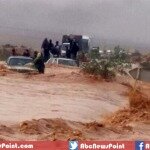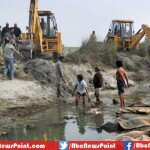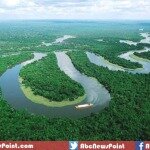8 Wonderful Buildings That Appeared From Water
1. The Church From Mexican Lake
The leftovers of a Colonial-period church arose in, from the disappearing waters of a waterway flowing in the Chiapas’ southern Mexican municipal. A drought hit the Grijalva River that year, affecting the level of water in Nezahualcoyotl Lake to reduce by 82ft. The church was constructed in the sixteenth century by some of monks in the region of Quechula, which was previously occupied by the people of Zoque. It was lost to Nezahualcoyotl lake’s waters in 1966 after the flood.
2. The Island in Turtle Shape
A large number of Chinese travelers herd to Gorges Reservoir in order to grasp the spectacular sight of an indefinable island in turtle shape upsurge from Muodaoxi River waters. The occasion is rejoiced by inhabitants because turtles are thought to be favorable and a symbol of durability. It echoes like a captivating natural wonder, but the “charm” is manufactured by man. The Muodaoxi River’s water level is organized by 3 Gorges Dam. The lake provides water to downstream regions every spring, bringing the level of water down and revealing the island.
3. Villa Epecuen
In 1920s, there was a vacationer village called Villa Epecuen. The village was set up beside the coasts of Lago Epecuen, a salty stream located in Argentina around 600km Buenos Aires southwest. Lago Epecuen is an ordinary lake like other mountain lakes, but it has the exception of having highest salt levels 2nd just to the Dead Sea. Moreover, it is 10 times higher than the rest of oceans.
The population of the town was highest in 1970s measuring a total of around 5,000 people. It was encompassing more than 300 300, involving museums, shops, spas, hostels and hotels. At that time, a long-standing climate delivered exceptional rain quantity as compared to nearby hills, and the lake of Lago Epecuen began to swell. Finally, a great amount of water broke out the dam on 0th November 10, 1985, and flooded major area of the town. By 1993, this flood slowly covered the whole town under ten meters of water.
In 2009, almost after 25 years, the wet weather conditions underwent a reverse and the waters started to drain. By this, Villa Epecuen began showing its face to the surface. There was no body that came back to the down except Pablo Novak, 81. He is presently the sole inhabitant of Villa Epecuen.
4. St. Nicholas
Mavrovo Lake is situated near the utmost waterfall in the Balkans lays. It is a national park in Macedonia which is recognized for its partially-submerged church. Located in wonderful scenery among grassy snowy peaks and plateaus, the uninhibited St. Nicholas church was supposedly the prey of an artificial lake formed to stream water to a home-grown power plant.
The St. Nicholas’ top half still can be seen. It is rising from the lake closely offshore of the community that it used to serve once. Presently, you can see weeds growing from the remains and tower’s overlaid roof is crumpling, but this tumbledown building will continue to sustain an attraction for many upcoming years.
5. Grüner See
To See More (Hiking Actually Improves Our Brains Activity)
The Grüner See is situated in Styria, Austria. Well recognized for its picturesque sights and emerald-green water, it is also known as Green Lake. The lake drops down from the nearby snow-covered mounts. In the winter, before the melting of ice, the 1-2 meters deep lake along with the nearby area serve as a county park. Though, by spring, the land basin underneath the mountain plugs with water, converting the lake into an submerged sanctuary thoroughly 12 meters deep. The Grüner See is surely a pollution-free and an enormously widespread traveler destination for campers, hikers and adventurers people who are in love with nature.
6. Xuanping village
These surprising images display a whole village evolving from a lake 5 years after its complete destruction by the flood resulted due to an immense earthquake. Nearly 10 buildings including a primary school, offices and homes that have arose from the water since the destruction of Xuanping village in 2008. The village was destroyed by an earthquake of 8.0-magnitude in Beichuan County, followed by a sever flood by a nearby lake.
7. St Thomas
The city of St Thomas was swamped before 70 years by the growing waters of the River of Colorado. It happened because the river needed to get dammed for creating Lake Mead. Its remnants are now uncovered as ongoing drought keeps the lake near low levels, historically.
Thomas was set up in 1865 at the convergence of the Virgin and Muddy Rivers by Mormons send off to Nevada’s southern regions to plant cotton and enlarge the spread of their church to the west shoreline. The city had grown-up to a populace of five-hundred by the time it was flooded in 1938.
Saint Thomas submerged concrete grounds were first noticed in 2003by fishermen. Currently, tamarisk scrubs cover the area.
8. The Church of Potosi
Venezuela: Between 1985 and 2008, daytrippers and fishermen roving by boat beside the lake made in Táchira by the Uribante Reservoir, saw a spooky sight—a musty cross rising shadily out of the water. It was clear that the cross was attached to something fastening it—something deep and big underneath the surface. In 2008, it began to rise higher out of the water, exposing more of its gothic structure. It was exactly only the tip of something really huge. In fact, it was not the structure coming out of the water; rather lakes’ water was going down, exposing what the lake had buried for over 2 decades. The water dried entirely by 2010, exposing a huge stretch of land and a soaring, gothic church which was nearly flooded once.
The church was associated to the Potosi city, which was intentionally flooded in 1985 by the damming of a closing river to make hydroelectric power.



























